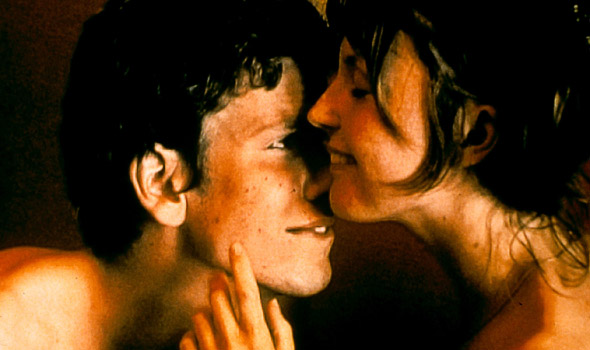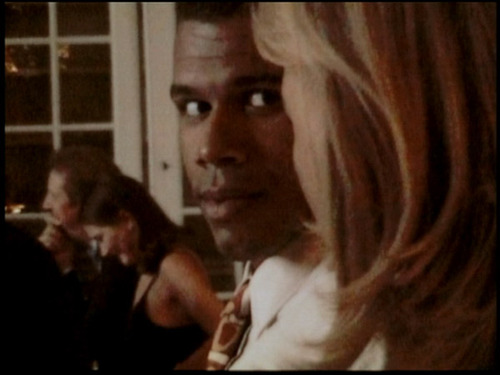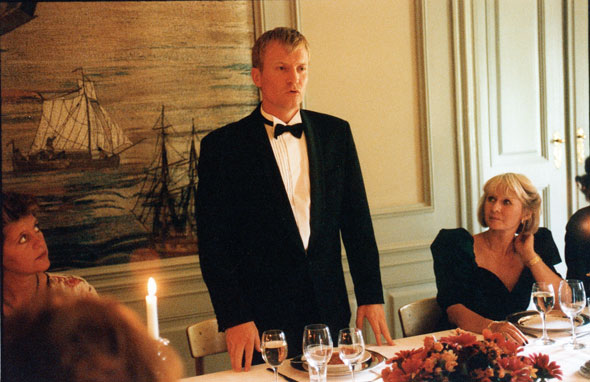From the Chicago Reader (November 13, 1998). It seems like there are some cinephiles around who still regard Dogme 95 as an honest-to-Pete aesthetic position and not as a lucrative business, ignoring that as far back as 2000, official Dogme Certificates were being sold in Denmark for roughly $1,000 apiece — apparently as a adjunct to von Trier’s main form of income, his ongoing porn-film business (which has also been widely ignored). — J.R.

The Celebration
Rating *** A must see
Directed by Thomas Vinterberg
Written by Vinterberg and Mogens Rukov
With Ulrich Thomsen, Henning Moritzen, Thomas Bo Larsen, Paprika Steen, Birthe Neuman, Trine Dyrholm, and Helle Dolleris.
In 1961 we wrote this manifesto of the New American Cinema. Eugene Archer was working for the New York Times then, and I showed it to him and asked him if they could print it. He said, ‘No, we couldn’t — maybe the Village Voice could run it.’ Then I understood, of course, that the only kind of manifesto that the New York Times would print would be a press release, not a manifesto at all. In the same way, for an idea to get into the Village Voice today, it has to become not an idea but something else. — Jonas Mekas
Mekas said this to me 16 years ago. If Danish filmmakers want to get our attention today they have to write not a press release — everybody writes those now — but a manifesto. At least I assume that’s one reason four Danish filmmakers — Christian Levring, Soren Kragh-Jacobsen, Thomas Vinterberg, and Lars von Trier — drafted a manifesto three years ago for an impromptu organization they named Dogme 95. Called “The Vow of Chastity,” this document reads in part:
“I swear to submit to the following set of rules drawn up and confirmed by Dogme 95:
“1. Shooting must be done on location. Props and sets must not be brought in. (If a particular prop is necessary for the story, a location must be chosen where this prop is to be found.)
“2. The sound must never be produced apart from the image or vice versa. (Music must not be used unless it occurs where the scene is being shot.)
“3. The camera must be hand-held. Any movement or immobility attainable in the hand is permitted. (The film must not take place where the camera is standing; shooting must take place where the film takes place.)
“4. The film must be in color. Special lighting is not acceptable. (If there is too little light for exposure, the scene must be cut or a single lamp [must] be attached to the camera.)
“5. Optical work and filters are forbidden.
“6. The film must not contain superficial action. (Murders, weapons, etc. must not occur.)
“7. Temporal and geographical alienation are forbidden. (That is to say that the film takes place here and now.)
“8. Genre movies are not acceptable.
“9. The film format must be Academy 35 mm.
“10. The director must not be credited.
“Furthermore, I swear as a director to refrain from personal taste! I am no longer an artist. I swear to refrain from creating a ‘work,’ as I regard the instant as more important than the whole. My supreme goal is to force the truth out of my characters and settings. I swear to do so by all the means available and at the cost of any good taste and any aesthetic considerations.”
Making allowances for what’s been lost in translation — “murders” constitute “superficial action,” “weapons” might “occur” — the most striking thing about this document is that it revives some of the most tired cliches about documentary realism that have ever been bandied about. It even appears to embrace the philosophically absurd notion that the events of any film can take place “here and now,” when all sorts of things, including editing, must happen before filmed events can be seen in theaters. The manifesto appears to be calling for a documentary aesthetic, but since the events to be filmed are presumably staged and fictional, the notion of where “truth” lies in this mix is far from spelled out.
The assumption that “art” and “realism” are antithetical or at least incompatible has played some role in just about every formal and stylistic change in painting, literature, theater, and film that has come our way in the West this century — though “The Vow of Chastity” seems to be proposing less a new form of work than a throwback to older practices that too much technology and industrial habits have tended to muck up, along with some dubious implied notions about the relation of color and 35-millimeter to “reality” (as opposed to “art”).
Yet viewed as the ground rules for a kind of game, this manifesto deserves to be judged by its results. As far as I know, only two features to date have emerged from “The Vow of Chastity,” Vinterberg’s The Celebration and von Trier’s The Idiots, both of which surfaced at Cannes last May. There may have been more such features, but Americans have few sources of information about current Danish cinema apart from circuses like Cannes and the sketchy press material offered by U.S. distributors.
I saw The Idiots in Paris last May, and apart from one well-realized scene, I found it decidedly underwhelming — a pastiche of 60s rebellion with virtually all of the 60s politics removed. Stylistically, it registered as a hollow imitation of John Cassavetes, thematically as a bourgeois cautionary tale about the dangers of straying too far from hearth and home. My sense that von Trier is a poseur, a sometimes talented charlatan, certainly didn’t make me an impartial witness, but we’ll all have a chance to judge next year when the film is released by October Films with its MPAA-imposed cuts.
The Celebration, which I caught up with in Toronto in September, clearly found more favor with the Cannes jury, who accorded it their special jury prize, and I must confess I agree with them. All the buzz I’d been hearing about Dogme 95 (which has assured the U.S. distribution of both films) reminded me more of von Trier’s genius for personal publicity than of a response to innovative work — and reminded me in some ways of what gave me pause about Werner Herzog in the 70s, when his status became legendary. But Vinterberg’s film took me by surprise; its devices seemed at once fresher and more traditional than all the attention-getting ones I associate with von Trier, on-screen and off.
Maybe this is because Vinterberg has a better story to tell — a set of strategically planted and finely calibrated revelations about a family’s dark secrets during a weekend gathering at a country mansion occasioned by the father’s 60th birthday. The writing displays a discipline and craft I haven’t found in any of von Trier’s work, creating a sculpted effect I associate most with the plays of Henrik Ibsen. Admittedly, the behavior of many of the characters is so monstrously rude and vicious that I was initially reminded of that other great Scandinavian playwright August Strindberg, which made me wonder if Vinterberg were staging an improbable synthesis of the two (much as, according to Susan Sontag, Peter Weiss’s Marat/Sade was an improbable synthesis of Bertolt Brecht and Antonin Artaud). But this resemblance proved deceptive: Strindberg’s moods are expressionistic and dreamlike — precisely the reverse of the realism Dogme 95 calls for and Vinterberg supplies. The impact of The Celebration is something closer to what might be termed punk Ibsen — Ibsen shorn of his politics and his impulse toward social reform. Insofar as the substitution of the personal for the political already informs most of Anglo-American public life, including the enduring tradition of punk defeatism, this is a fairly unexceptional spin on the material — and it’s dangerously close to what I find repugnant about von Trier’s work, albeit without a complacent bourgeois affirmation tacked on at the end. But to Vinterberg’s credit, he allows his story to follow its own logic and doesn’t chase after transcendental meanings.
It wasn’t only the story that won me over to Vinterberg’s cause. The Celebration was shot with the smallest digital video camera available, a Sony PC7, which fits in the palm of a hand (it’s no longer manufactured, but I’m told that it has recently been replaced by the similar Sony PC10). This produces a rather blotchy, grainy image when transferred to 35-millimeter. Vinterberg frames and edits it with such eccentric yet logical abandon — cutting to sudden overhead shots, crosscutting between as many as three simultaneously unfolding scenes, and jump-cutting at regular intervals — that he counteracts the continuity of the plot with as much discontinuity as he can without losing the threads of the action. I might say that this is a kamikaze documentary of a well-constructed three-act play, but that would give a false impression; after all, his method of shooting and editing is as much a form of construction as his writing, and it’s largely the rhetoric of documentary that allows him — and Dogme 95, for that matter — to create an illusion of randomness. Paradoxically, the mistrust of high-tech filmmaking techniques reflected in “The Vow of Chastity” is contradicted by the exciting uses made of the Sony PC7 throughout. The crucial point is that the equipment itself is never — and can never be — exciting in itself. The uses it’s put to make the difference, and this is where artistry, “personal taste,” and the “whole” in contrast to the detail — all the things that Dogme 95 pretends to disdain — come in.
In fact, the plot and the style are both founded on deceptive appearances. What appears to be out-of-control behavior by the eldest son, Christian (Ulrich Thomsen), is in fact a series of carefully staged events, planned with the complicity of the kitchen staff; what appears to be an out-of-control recording of this behavior is in fact a model of careful exposition, executed with the full cooperation of camera crew and editing assistants. It would be unwise to say much more about a story and style that depend on our ignorance, but I’ve seen this movie twice and both times was held by the mesmerizing storytelling every step of the way. However, it’s surely a form of coquetry for Vinterberg to leave his name off the credits when he knows we’ll know it anyway, and it’s a similarly ironic subterfuge to use the dubious principles of Dogme 95 as a means to discipline his artistic choices as well as liberate them.





